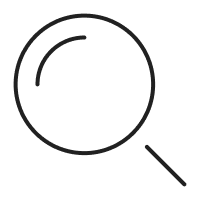Four steps to a better search
A thorough search gives you overview. What literature is available within the topic?
Here you have four steps to a better search; 1. Good search terms, 2. Relevant bibliography article databases, 3. Use: AND – OR – NOT and 4. Evaluate result and be critical

Step 1: Chose good search terms
Keywords alias subject headings or descriptors, are already in your research question and chosen title.
You can find more keywords in:
– articles, books written by authors that are researching the topic.
– dictionaries, article databases, reports, books, encyclopledia etc
Find synonyms, related concepts, broader /narrower terms and possible abbreviations for your keywords
BIBLIOTEKSRESSOURCER (LINKS)
Some bibliographic article databases have an online thesaurus
Use both English and Latin names for plants & animals
Step 2: Know how to use: OR – AND – NOT
You have the keywords and chosen the article databases and now you have to use the operators: AND, OR and NOT
You have to combine all related keywords (headings, identifiers, etc.) you can find, to get a broad search.
An example on a title: “Overweight among Danish women”
- Search 1: woman OR women OR female OR females
- Search 2: Overweight OR obesity
- Search 3: Danish OR Denmark
And after that combine all three with AND to narrow:

You can also use NOT to exclude keywords
You can also delineate with for example publication year and language, if you have too many sources.
BIBLIOTEKSRESSOURCER (LINKS)
Truncation/wildcards are used to search the root of the word. The truncation sign (wildcard) is often an asterix: *. It replaces often zero to many letters. Sometimes the wildcard can be a question mark (?) or a dollar sign $.
Step 3: Find relevant bibliography article databases
It is fine to include Google, or even better Google Scholar, in your search. However, if you really want to optimize and have detailed control of your search, you need to use an article database – also called bibliographic databases:
“A bibliographic database is a database of bibliographic records, an organized digital collection of references to published literature, including journal and newspaper articles, conference proceedings, reports, government and legal publications, patents, books, etc.”
wikipedia
A bibliographic database may be general in scope or cover a specific academic discipline”
Copenhagen University Library gives you, as a student, access to many article databases (Open the Subject guides)
Always search in more than one article database. They all have unique sources – and you want them all 🙂
BIBLIOTEKSRESSOURCER (LINKS)
Step 4: Evaluate the search result and be critical
Now when you have found all this sources, articles, books, reports etc – then you need to give them a critical look.
To be sure if a source are reliable or unreliable, you can ask yourself if the source is objective, relevant, reliable or/and accurate?
BIBLIOTEKSRESSOURCER (LINKS)
Step 5: Copenhagen University Library
You are always welcome to get in touch with your library!
KUB Frederiksberg (Science)
KUB Nord (Natural and Health Sciences)
KUB South Campus (Humanities, Law, and ITU)
- Engerom library
- KOMM & IKK libraries (joint services at KOMM library)
- NorS library
- ToRS & Saxo library (joint services at ToRS library)